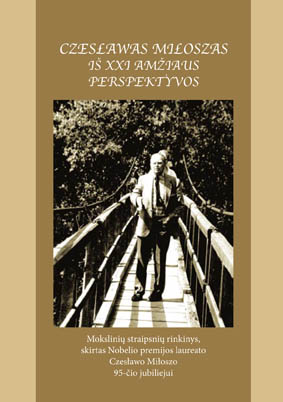Czesławo Miłoszo Ginie ir lietuviškų vietovardžių kontekstas
Ginie by Czesław Miłosz and the Context of Lithuanian Placenames
Author(s): Nijolė TaluntytėSubject(s): Literary Texts
Published by: Vytauto Didžiojo Universitetas
Keywords: Czesław Miłosz; konferencija; conference; Kaunas
Summary/Abstract: Proper names in a work of fiction constitute an important device of textual stylistics. The aim of this paper is to interpret the function of the placename of the settlement Ginie, which is mentioned in “Isa Valley” by Czesław Miłosz. In the novel, the toponym is used in various grammatical cases. Having collected all examples of case usage, it is possible to state that the placename Ginie is declined according to the neuter singular paradigm of the Polish language. The structure of the placename – the Lithuanian Polonized stem and the Polish segment of the ending – is a way of Polonization of Lithuanian settlements of the 18th century. The root (stem) gin- is encountered in the structures of toponyms and anthroponyms of 16th to 18th centuries, and it constitutes one of the segments in two-stem anthroponyms and on their derivatives oikonyms. The segment of the ending -ie presupposes double interpretation. The form Ginie may be interpreted as the Polonized form of Nominative plural of a Lithuanian placename (oikonym) *Giniai (Lithuanian stem gin- and Polish ending -(i)e). The fundament of a pluralia tantum oikonym *Giniai could be the personal name Gínius (a shortening of a personal name with gin-). This tradition of Polonization of Lithuanian placenames dates back even to the 18th century. Nominative singular of Lithuanian hydronyms in Polish forms acquires neutrum -(i)e. This is the strategy of the Polonization of Lithuanian (i)ia hydronyms with endings -is, -ys, -ius. The derivativesof Lithuanian feminine gender toponyms with the ending -ė in the Polish forms of the 18th century also acquires the polish neutrum formant -(i)e. The specific interaction of Lithuanian and Polish placenames the way it is recorded in sources is observable in the structure of the placename Gynie. The form Gynie as it is used by Czesław Miłosz is transferred in accordance with the Polonization model of Lithuanian placenames which developed in the Grand Duchy of Lithuania at the time of using Polish as the official language. The writer who was born in a Polish-speaking family also accepted the specific features of the use of the Polish language in the Grand Duchy of Lithuania.
Journal: Česlovo Milošo skaitymai
- Issue Year: 2007
- Issue No: 1
- Page Range: 99-110
- Page Count: 12
- Language: Lithuanian

